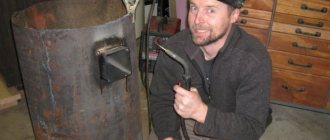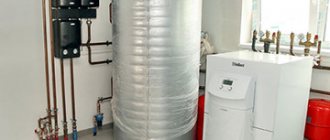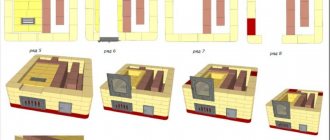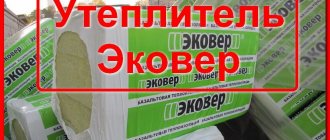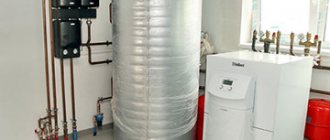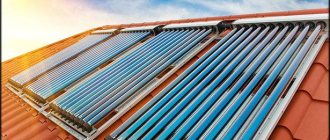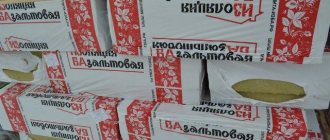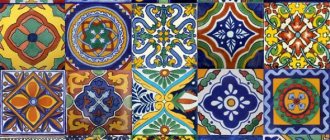Clay is a sedimentary rock whose physical properties depend on the presence of the minerals that make up its composition.
Fireproof (fireclay) clay has the most valuable properties. This rock is obtained by firing kaolin (white clay) at high temperatures (not lower than 1000 degrees). This is done in order to increase the heat resistance of the material. During the heat treatment, impurities and liquid are completely evaporated from the clay.
In special furnaces, the rock acquires the high-strength properties of stone, which is subsequently crushed to form fireclay. It is used for the manufacture of refractory bricks, stoves, heating appliances and decorative elements.
Heat-resistant clay for bricks is, first of all, a workpiece for creating building materials by grinding and adding various substances. Fireclay has many subspecies due to the heterogeneity of raw materials and firing methods.
Advantages of refractory clay
Among the advantages of this building material the following are noted:
- Long service life. The solution does not crack, does not crumble, and retains its original shape.
- Has excellent adhesive properties. Grips well on any surface.
- Vapor permeability.
- Resistance to various temperatures.
- Clay is an environmentally friendly and completely safe product.
Plaster
Plastering with fireclay clay is similar to the process of working with simple plaster. To do this, use two spatulas of different sizes. Enough to finish the oven. For such work you do not need to prepare special tools.
When applying the solution, do not forget about spreading drops. They should be picked up with a spatula. When applying a layer of plaster, its thickness must be taken into account. It should not exceed 1-2 mm. Finishing work can begin only after the plaster has dried. Fireclay bricks are not wetted by water.
Rules for purchasing material
Before choosing refractory clay for laying stoves, you need to study the digital combination (mortar) marked on the packaging label. The higher the number, the higher the fire resistance. Other indicators may vary. The marking indicates not only the area of application, but also information about which bricks can be laid.
Particular attention must be paid to the expiration date. If it has expired, such clay should not be purchased, since kaolin loses its technological properties, which must comply with GOST 6137-8.
Furnace design and masonry mortar
Brick sauna stoves are large structures, their parts function in different conditions. The humidity level and temperature conditions at the base of the stove, next to the firebox and in the chimney duct are different. Temperature delta can reach from 0 to 1000 degrees or more. Smoke passes through the firebox and chimney. In addition, the pipe is exposed to rain, wind and cold. A universal mortar that would fit all these parameters and withstand them with honor has not yet been invented.
Cement or lime, either together or separately, cannot withstand such a temperature range.
In addition, it should be borne in mind that fire-resistant solutions are expensive. It is advisable to use them where the maximum temperature develops. But for the foundation and main structural parts of the furnace, you can prepare cheaper mixtures. Clay is considered a relatively inexpensive building material. If you wish, you can obtain it yourself, and then the solution will be practically free. All that remains is to determine its quality and suitability for masonry and prepare it in a special way.
Clay sand mortar for furnaces is also sold and manufactured in factories. There is already a calculated ratio of components. The big disadvantage is their high price; the oven will turn out golden, because you need quite a lot of solution. For comparison: for 100 bricks you need about 2-3 buckets of the mixture. The exact quantity depends on the thickness of the seams and the density of the rows. Each master has his own style of masonry and, accordingly, the consumption of mortar.
If you recalculate factory mixtures to the actual scale of construction, then thrifty owners will not be pleased with the price. Therefore, you can take a closer look at budget masonry mortars that you can make yourself. It is also possible to prepare clay for ovens with your own hands; the composition of the solution will not be affected.
Specifications
Among them the following are noted:
- The moisture absorption of high-firing fireclay is up to 10%, low-firing – up to 25%.
- The grain fraction must correspond to 2 mm.
- Fire resistance – up to 1850 degrees.
- Humidity – no higher than 5%.
A package of fireclay clay (20 kg) is enough to lay no more than 30 bricks. In order to produce 1 m³ of masonry, 100 kg of kaolin is required. A high-quality solution hardens within several days if the temperature is not lower than +10 degrees.
The shelf life in industrial packaging is 3 years from the date of manufacture.
Properties of fireclay
All characteristics are standardized by GOST requirements, the main of which are heat-resistant abilities.
Depending on the brand, ground fire clay should and can withstand heating up to 1580 or even 1730 °C. The chemical composition is based on aluminum and silicon oxides; in addition, trace amounts of iron, calcium, magnesium, sodium, and potassium oxides are present.
If the aluminum oxide concentration reaches 40%, the refractory clay is called highly basic; when the mass fraction of this oxide is from 26% to 38%, the raw material is simply called basic. If the specific gravity of aluminum oxide does not reach 27%, the raw material is called semi-acid. The moisture content remaining in fire-resistant ground clay is usually 5%.
The material retains its properties for 3 years if storage rules are observed, including normal values of air humidity and temperature; maintaining the integrity of the original packaging. A high content of water vapor and cold in the room can lead to the loss of the declared qualities of fire-resistant products.
How to prepare clay
To create a solution, you will need to take a package of powder, pour it into a working container and add water. To obtain a high-quality mixture, it should be infused for at least 3 days. Next, you need to gradually add water, stirring continuously until smooth. Some experts advise using a little sand.
When working with refractory clay for laying stoves, you need to remember that the basis for success is constant stirring. If it starts to thicken a little, you need to add a small amount of water. When obtaining a liquid consistency, you need to add powder.
To properly dilute the clay, you need to calculate the amount of water used. The finished solution will have a consistency similar to sour cream. When applied to the wall surface, the mixture should not “float” or run off. If the composition is dry, it will crumble and crumble.
When using clay for instant work, the process of preparing the mixture will be much faster, since it is not necessary to infuse the solution for 3 days.
The resulting clay must be applied with a spatula. A small tool is used to promptly pick up drips and eliminate unevenness. At the end of the work, the finished surface should dry.
Clay-sand mortar
Sold in construction stores or prepared with your own hands. When it is possible to obtain clay, the mixture is practically free. A solution of clay and sand is the main one, since it is used for laying almost the entire furnace. An exception is a chimney pipe with a foundation, since the moisture resistance of the resulting mixture is quite low.
A kiln mortar based on sand and clay interacts well with fired clay bricks. It has average strength, is resistant to fire, and, most importantly, does not allow gases to penetrate the substance. Another advantage is the possibility of secondary use. The solution has no shelf life limitation. It can be diluted with water and used again.
Clay
The basis of the oven solution, which, when independently “extracted”, requires the correct determination of fat content. Regular moistening with water and kneading in the hand is not enough. A more thorough check needs to be carried out. It can be made in different ways, but among the simplest and most accessible is kneading 2-3 liters of clay using a kneading spoon with plain water.
When the resulting mass almost completely sticks to the jig, it means that the clay has a high fat content and needs to be artificially depleted by adding sand. If the clay remains in small clumps on the tool, it is ideal for mortar and does not require any “rework.” This stage can be continued by directly mixing the masonry mixture, but the clay must first be cleaned. This also applies to sand, which must be washed.
Clay preparation
Properly selected clay should be pre-cleaned, which will significantly improve the quality of the material. It is enough to sift the dry material through a sieve with 2-3 mm mesh. Next, it is soaked, laid in layers of 15-20 cm, poured on top with water, and then a day later mixed with the addition of a small amount of liquid. When another 24 hours have passed, the completely swollen mixture is thoroughly stirred again. It is this clay that is used for the further preparation of the stove solution.
Sand cleaning
Purchased bulk material is usually sold washed, but it most often requires additional preparation. The presence of any foreign inclusions reduces the quality of the masonry mortar, and, therefore, affects the quality of the seams, which should not be allowed. It is enough to sift sand purchased in a store through a fine sieve with cells from 1 to 1.5 mm, while sand mined independently will require additional washing under high water pressure. On an industrial scale, sand is cleaned of organic components by heating to high temperatures, at which the bulk material is perfectly fine dries. You can do this at home, but only when you make a special installation yourself, which is impractical for laying out one structure.
Instructions for use
The material is widely used in the construction industry. In addition, due to its technical properties, clay is often used for the production of step elements, since it is perfectly fixed on any surface.
Furnace laying
Many specialists in laying stoves or open fireplaces use refractory bricks during installation, which are made from a clay-fireclay mixture. When purchasing material, pay special attention to the marking: it should have the letter Ш. Since the price of such bricks is much higher, the material is used only for laying the firebox. The rest of the device is made of universal brick.
Other products
Fireclay is a durable material that is especially loved by designers. They are attracted by its beauty, as well as its special texture. Many craftsmen make clay figurines, as well as various dishes. Such products can decorate even the most sophisticated interior.
All these advantages are achieved by adding special impurities to the clay. This allows you to give the material high ductility. Also, many craftsmen fell in love with this material because of its environmental friendliness. It is impossible to find harmful substances in fireclay clay.
To figure out how to make fireproof clay, you will need to know the recipe and the ratio of the elements of the finished mixture. When making artistic ceramics, it is necessary to take plastic clay of various compositions. Then fireclay chips are added to it. It usually has a concentration of 40%.
Before making crafts from fireclay clay, the master will need to make a sketch. After this, the master makes a mold and fills it with fireclay clay. After this, the material is left to dry. The product must be kept for a long time. This will allow it to acquire a certain shape and become durable.

